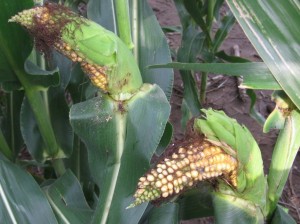 Source: Dennis Belcher, BASF, 2007. |
 Source: Dennis Belcher, BASF, 2007. |

Symptoms:
Ears are often misshapen and bend due to differential kernel formation and development along the length of the ear .
Because of this deformity, the problem is referred to by various names including “cow horn”, “boomerang”, or “banana” ears.
Causes:
Causes of “cow horn”, “boomerang”, or “banana” ear shapes include brown and green stink bug injury (see “Stinkbug Kernel Injury”). Ear deformities described as banana shaped have also been associated with ear zippering (see “Zipper Ears”).
Feeding injury on small developing ears before silking can deform ears into “cow horn”, “boomerang”, or “banana” shapes, resulting in total ear loss. Stink bugs probe plants with their beak-like mouthpart and inject enzymes into the plant tissue before removing plant juices. Significant ear damage is likely when ears are less than 3/4 inch long. The shuck will also stop developing, exposing the grain to weathering and other pests. Injury includes shrunken and/or missing kernels. Affected ears fail to develop properly and are more susceptible to infection by corn smut fungus.
Activity is most concentrated from the time kernels begin to form through the milk stage of development. Feeding can occur through the hard dough stage. Where stink bugs sting into the ear during early ear development, the cob will not develop on that side and it will continue growing on the back side giving the ear a characteristic banana shaped appearance. The shuck will also stop developing, exposing the grain to bird and insect damage. Injury also includes shrunken and/or missing kernels. Heavy stinkbug populations can reduce not only yields but also the quality of the grain.
Management:
Scout to determine when stinkbug thresholds are exceeded and insecticides are justified. Threshold levels vary depending on the grain fill stage. The most susceptible time for stink bug injury in corn is when the ear is forming, during ear elongation, and during pollen shed. Stink bugs feeding after the blister stage has a loose association with increased levels of aflatoxin.
References:
Michel, A., R. Hammond, C. Welty, and Thomison. 2013. Corn ears showing stink bug injury. C.O.R.N. Newsletter 2013-31. http://agcrops.osu.edu/newsletters/2013/31#4 [URL verified 3/28/2019].
Welty, C. and R. Precheur. Brown Marmorated Stink Bug Injury of Sweet Corn. 2013. Personal Communication. The Ohio State University.


